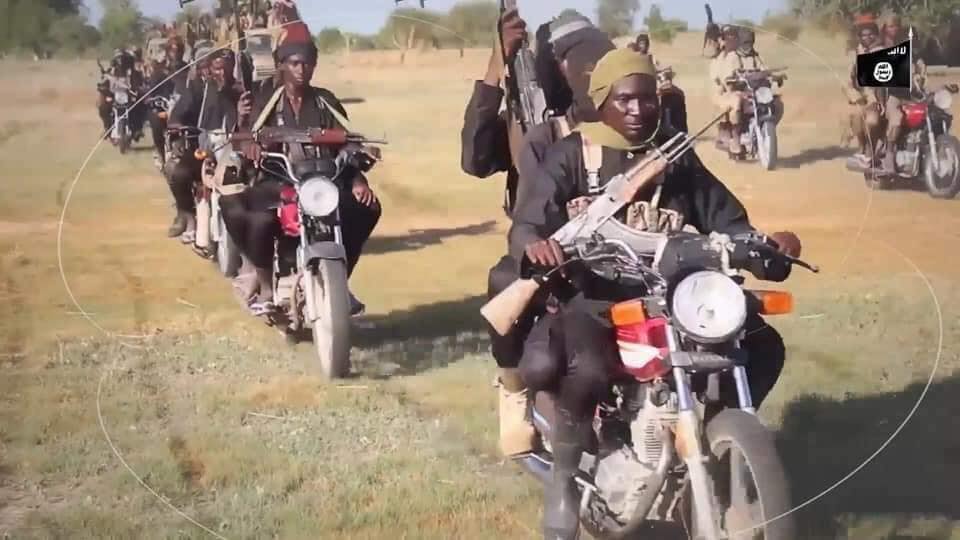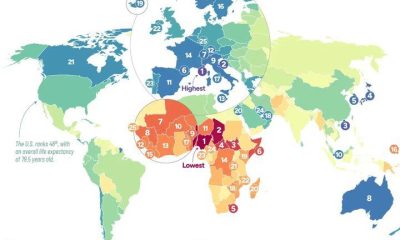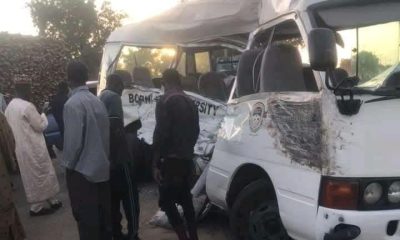Comments and Issues
The Famished Road to Kuriga
Published
2 years agoon

The journey to Kuriga in southern Kaduna, North-west Nigeria, did not start with the kidnap of 287 students last week. In the early 1990s a neighbouring town, Zango Kataf, was the boiling point.
About a decade later, the beast of sectarian violence, which had reared its head in Kaduna, surfaced several hundreds of miles away in two major places that have become the epicentres of insurgency: Borno and Yobe States, both in the North-east.
Even though misery travelled southwards aided by Mohammed Yusuf, the itinerant extremist Muslim preacher in Yobe whose activities heightened the rise of extremism in the early 2000s, Yusuf did not entirely pave the way for the mass kidnap in Kuriga last week.
The incompetence of the security services mixed with rampant poverty in parts of the North and the opportunism of the elite in the region helped in no small way to recruit the bands of misguided and rogue elements that have become a national plague.
That band, mixed with insurgents drifting southward from the Sahel, has been showing up as banditry in some areas, cattle rustling in other areas, and violent extremism elsewhere. In the process, hundreds have been killed, while Borno and Yobe have become Africa’s largest camps of internally displaced persons.
Kidnapping is the latest franchise. It shocked the world when over 200 girls were kidnapped from their school in Chibok and 58 boys killed inside their school dormitory in Buni Yadi, Yobe State. But since then, Amnesty International has documented 13 abductions in Nigerian schools.
Within 10 days last week, over 500 persons, mostly children, were taken hostage in different states and in separate attacks on IDP camps and schools.
Days after 200 persons were kidnapped from an IDP camp in Borno State, a school in Kaduna State was the next hunting ground. Two-hundred and eighty-seven students and pupils, with some staff, from the Local Government Education Authority (LGEA) Primary School, Kuriga in Chikun Local Government Area of Kaduna State were kidnapped during the school’s morning assembly.
Politicians, who shed crocodile tears for a living, visit crime scenes like Kuriga twice in their lifetime. They visit unfailingly during election campaigns and then grudgingly – more for the camera – at a time of grief, like this. Kaduna State Governor, Uba Sani, for example, was in Kuriga on Thursday, shortly after the students were kidnapped.
It was not a normal visit, like you would visit folks in your neigbourhood who had just suffered a loss. Kuriga or Birnin Gwari, another dangerous neighbouring town, has not been a normal place for years. Four years ago, for example, an NGO, WANEP, reported that 140 persons were abducted and 84 killed by bandits in Birnin Gwari.
Governor Sani’s visit
Eyewitnesses said on his visit to Kuriga, Governor Sani was prepared as if he was going to a warfront. Only one print journalist and a few others from broadcast stations, chosen by the Government House, were embedded in the governor’s convoy on that trip. Which means with telecommunications cut off, reports from there are second- third- or perhaps, fourth-hand accounts.
Residents of Chikun Local Government, with an estimated population of 550,000, have tried to get used to living under terror. Left largely on their own without government or security, they have accepted the authority of bandits and terrorists. These criminal gangs extort money from residents from N70,000 to N100,000 to have access to their farms. Those in Kidandan, Galadimawa Kerawa, Sabon Layi, Sabon Birni and Ruma whose names may not show on your Google map, are also affected.
Yet, these folks might even consider themselves lucky, if luck means paying through your nose to reach your farm. According to news reports, those in other local governments such as Igabi and Giwa, have abandoned their farms to terrorists. Other communities in Kaduna currently under siege are Kaura, Kajuru, and Zango Kataf.
Toll gates of Kuriga
Apart from tolling the farms for cash, illegal miners, using small fry, have also deployed their billing machines. They squeeze farm owners to give up their lands for peanuts, which they then mine for minerals. It’s a criminal enterprise that has been on for years. Like most criminal gangs, the ones in Kuriga have developed their own codes, fees, levies and commissions.
The decision of these syndicates to turn from extorting farmers and stripping their lands of mineral deposits to kidnapping students for ransom is an indication that kidnapping is paying more. That’s not a surprise. The Africa Report quoted SBM Intelligence that gunmen kidnapped at least 3,620 people across Nigeria between July 2022 and June 2023, with a ransom demand totalling over N5billion.
What is the government doing about it? And I’m not talking about the state alone; I’m also talking about politicians in Kaduna and Abuja elected to represent these communities. Where, for example, is Jesse David, who represents this distressed community in the State House of Assembly?
And where is Shehu Balarabe, who represents Birnin Gwari/Gwari Federal Constituency in the House of Representatives? How did they find their way to their constituency during the election campaign but have lost their way back when their people need them most?
Where is the Federal Government, which controls the army, the air force, the police and the state services? How are kidnappers or bandits or terrorists able to mobilise and seize 287 students and teachers from their school in daylight in Kuriga, about 20 minutes’ drive from Birnin Gwari that is supposed to have a military base?
Imagine, for a moment, the logistics involved in moving 287 persons, most of them children. From infographics published by LEADERSHIP the day after, it would take 144 motorcycles or 57 cars or 21 buses or five 4.8 Embraer-145 planes, to move that number of people.
Yet, for the umpteenth time since 2014, children were kidnapped in their numbers by bandits who still managed to plan, coordinate and execute this evil in an area supposedly cut-off from communications. How, for Christ’s sake, did that happen?
A trillion-naira industry?
Just as shocking for me has been the near total absence of outrage outside Kuriga. It’s this kind of eye-rolling, not-our-business kind of attitude that has brought us where we are: where what shocked the world 10 years ago in Chibok even spawning demonstrations and hashtags, appears incapable of moving the dial today, in spite of its scale and audacity.
Apart the Democratic Republic of Congo (DRC), the Central African Republic (CAR), and South Sudan, where the savagery of the Lord’s Resistance Army (LRA), led to 100,000 deaths, and the abductions of 60,000 to 100,000 children and the displacement of millions, only few countries have witnessed the scale of criminality that Nigeria has witnessed in what is supposed to be peace time.
It reminds me of Mexico in 2014. That year, also the year of the Chibok Girls, 43 students were kidnapped by a drug cartel and years of agonising search yielded no clues. Until last year, when long after the students had been murdered, investigations revealed that government officials were employees of the cartel.
According to the New York Times, text messages exchanged between the cartel and government officials even found that first responders on the crime scene were on the cartel’s payroll! Which partly explains why it took so long to unravel the crime.
It’s heart-wrenching to think that even though we’re told that Kuriga and other affected parts have been cut off from communications, we still hear of the criminals asking for ransom and issuing threats!
It may be far-fetched to assume official complicity in Kuriga. It’s foolish, however, to think that kidnapping became a trillion-naira industry without support from outside the gangs. Until we thoroughly investigate the kidnappers’ support system and expose and punish the kingpins, we’re wasting time.
Who knows where this is going to happen next?
Ishiekwene is Editor-In-Chief of LEADERSHIP
Trending

 Comments and Issues7 days ago
Comments and Issues7 days agoNigeria’s Life Expectancy as World’s Lowest

 Health1 week ago
Health1 week agoFDA expands probe into COVID-19 vaccine-linked deaths

 Latest6 days ago
Latest6 days agoChristmas rush triggers surge in transport fares from Lagos to South-East

 News1 week ago
News1 week agoFoundation commemorates 10th anniversary set to lift Edo indigents economy

 Latest1 week ago
Latest1 week agoEight UNIJOS students, driver killed as trailer crashes into bus

 Comments and Issues1 week ago
Comments and Issues1 week agoProtecting A Neighbor While Failing Nigerians: A Misplaced Priority?

 Uncategorized5 days ago
Uncategorized5 days agoCVR: INEC records 139,251 applications in Lagos

 Labour1 week ago
Labour1 week agoPolice debunk viral video claiming officer caught stealing, arrests 13 for assault

